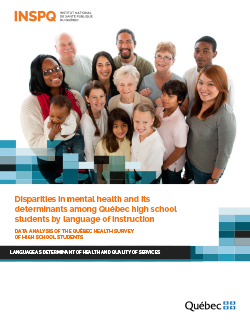Disparities in mental health and its determinants among Québec high school students by language of instruction

This paper provides a comparative analysis of several mental health indicators and determinants by language of instruction. All data discussed in this analysis is from the Québec Health Survey of High School Students 2016–2017.
For most of the indicators analyzed, there is no disparity between students in English and French high schools. When there is a gap between the two groups, it can be to the disadvantage of students taught in either language.
For example, a greater proportion of students in English high schools reported that they:
- Had been medically diagnosed with depression
- Had been medically diagnosed with an eating disorder
- Did not feel healthy
- Slept less than recommended during the school week
- Had poor social support from their family
- Had low overall self-efficacy
- Had been bullied at school, on the way to school, or online during the school year
- Had been attacked by gang members at school or on the way to school during the school year
In contrast, a lower proportion of students in English high schools reported that they:
- Had been medically diagnosed with ADHD
-
Had taken medication to help them calm down or focus in the previous 2 weeks (among those who had received a medical diagnosis of attention deficit disorder with or without hyperactivity);
- Had used alcohol excessively (5 or more consecutive drinks) at least once in the previous 12 months
- Had used an electronic cigarette
- Had poor social support from their community
- Had been violent with their romantic partner at least once in the previous 12 months
- Were likely to drop out of school
While the results do show some disparities based on language of instruction (English or French), all high school students can experience mental health problems and situations that are detrimental to their well-being.


